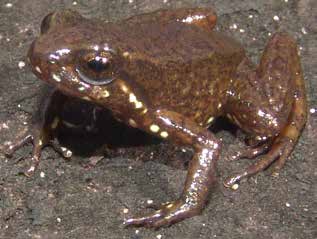
Herring are forage fish, mostly belonging to the family Clupeidae.
Bonnetia bolivarensis is a species of flowering plant in the Bonnetiaceae family. It is found only in Venezuela, known only from a single locality in the summit savanna of Ptari-tepui, in Canaima National Park in Bolívar.

Bonnetia is a genus of flowering plants in the family Bonnetiaceae. Most of the roughly 30 species are shrubs. The remaining species, all trees, are among the dominant species in the forest vegetation on the tepui plateaus of northern South America, such as B. roraimae on the summit of Mount Roraima.
Bonnetia celiae is a species of flowering plant in the Bonnetiaceae family. It is found only in Venezuela.
Bonnetia chimantensis is a species of flowering plant in the Bonnetiaceae family. It is found only in Venezuela, occurring in the Canaima National Park, where mining and tourism are threatening habitats at lower elevations.
Bonnetia cordifolia is a species of flowering plant in the Bonnetiaceae family. It is found only in Venezuela.
Bonnetia fasciculata is a species of flowering plant in the Bonnetiaceae family. It is found only in Venezuela.
Bonnetia holostyla is a species of flowering plant in the Bonnetiaceae family. It is found only in Colombia.
Bonnetia jauensis is a species of flowering plant in the Bonnetiaceae family found only in Venezuela.
Bonnetia lanceifolia is a species of flowering plant in the Bonnetiaceae family. It is found only in Venezuela.
Bonnetia maguireorum is a species of flowering plant in the Bonnetiaceae family. It is found only in Venezuela.
Bonnetia multinervia is a species of flowering plant in the Bonnetiaceae family. It is found only in Venezuela.
Bonnetia ptariensis is a species of flowering plant in the Bonnetiaceae family. It is found only in Venezuela.
Bonnetia rubicunda is a species of flowering plant in the Bonnetiaceae family. It is found only in Guyana.

Anomaloglossus rufulus is a species of frog in the family Aromobatidae. It is endemic to Venezuela where it is known from a few tepuis in the Chimantá Massif in the Bolívar state.
Bat Conservation International (BCI) is an international nongovernmental organization working to conserve bats and their habitats through conservation, education, and research efforts.

The World's 25 Most Endangered Primates is a list of highly endangered primate species selected and published by the International Union for Conservation of Nature (IUCN) Species Survival Commission (SSC) Primate Specialist Group (PSG), the International Primatological Society (IPS), Global Wildlife Conservation (GWC), and Bristol Zoological Society (BZS). The IUCN/SSC PSG worked with Conservation International (CI) to start the list in 2000, but in 2002, during the 19th Congress of the International Primatological Society, primatologists reviewed and debated the list, resulting in the 2002–2004 revision and the endorsement of the IPS. The publication was a joint project between the three conservation organizations until the 2012–2014 list when BZS was added as a publisher. The 2018–2020 list was the first time Conservation International was not among the publishers, replaced instead by GWC. The list has been revised every two years following the biannual Congress of the IPS. Starting with the 2004–2006 report, the title changed to "Primates in Peril: The World's 25 Most Endangered Primates". That same year, the list began to provide information about each species, including their conservation status and the threats they face in the wild. The species text is written in collaboration with experts from the field, with 60 people contributing to the 2006–2008 report and 85 people contributing to the 2008–2010 report. The 2004–2006 and 2006–2008 reports were published in the IUCN/SSC PSG journal Primate Conservation,, since then they have been published as independent publications.




